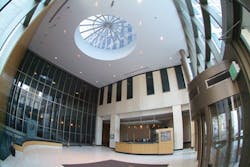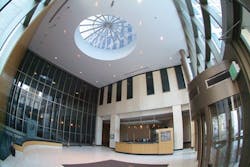Improve Your Building’s Public Spaces
By Maureen Orsborn
Through its Urban Development/Good Neighbor and First Impressions programs, the General Services Administration (GSA) is working to improve the public spaces in and around its buildings. By encouraging the creation of vibrant public spaces that extend from federal buildings into surrounding neighborhoods, the GSA hopes to show its commitment to making communities across the nation even better. The GSA has partnered with New York City-based Project for Public Spaces (PPS) to make improvements to federal buildings and plazas in 24 cities. They took the lessons learned during those projects and developed Achieving Great Federal Public Spaces: A Property Manager's Guide, a tool that guides GSA property managers through large and small projects that will enhance the public spaces in their buildings.
Although it's geared toward government buildings, Achieving Great Federal Public Spaces shows property managers in any building how easy it is to start with small changes that can make a large impact and generate momentum for larger, more expensive projects. "This guide is really a meat-and-potatoes kind of approach to make that happen," says Tony Costa, GSA Public Buildings Service deputy commissioner, "because, a lot of times, when people think about public places, they think about big projects, big design, and big construction, which is a part of making a good public place. But, we wanted to ensure that our property managers had tools and had the ability to think about greater plans and about things that they could do on an everyday basis."
Check out Achieving Great Federal Public Spaces: A Property Manager's Guide and use it as a model to get started on projects of your own.
How the Guide Works (and How it Can Work for You)
Section 1 provides the GSA's list of public-space goals (to reflect the dignity of government, be secure and welcoming, improve tenant satisfaction and revenue, serve as a forum for public use, and promote downtown revitalization). It also introduces six action points that map out strategies for evaluating and improving the interior and exterior public spaces of buildings. These points cover management, design, security, aesthetics, access and circulation, and access to local resources. While the goals and action points listed in the guide may not be the same ones you select for your building, before you embark on a mission to improve your facility's public spaces, it's a good idea to list your project goals and the strategies that will get you there.
Section 2 includes a ready-to-use checklist for completing an on-site evaluation of a facility's space. In about 30 minutes, GSA property managers take note of each property's public spaces and, based on immediate impressions, score each item on a numbered scale. The guide encourages property managers to invite "stakeholders" - representatives of tenant agencies, tenants, GSA colleagues, security personnel, and other interested parties - to also complete the evaluation. After the on-site evaluation is completed, a detailed scoring section helps the group interpret the results. Take a look at the worksheet and checklists in this section and think about how some of these questions might apply to your facility's public spaces (or use them as a starting point to create a list of questions you could ask to conduct your own evaluation of the current condition of your building's public spaces).
Section 3 provides solutions for aspects of the public space that need improvement. For each of the six action points presented in Section 1, short-, medium-, and long-term projects are suggested to address these points. They may be perfect solutions, or they may just serve as a starting point or a way to generate ideas. Short-term projects are recommended when resources are limited, while waiting for approval for a major project, or to generate interest from clients and the community. Planning for medium- or long-term projects can take precedence when the public space is already performing well in a given category. The ideas listed here may not work for your facility and the challenges it presents, but the suggestions are good and will at least get the ball rolling. Use them as a starting point for your own solutions.
Section 4 lists steps for implementation. The steps are divided into two categories: internal implementation steps, which can be completed by property management or with assistance from other GSA colleagues, and external implementation steps, which require collaboration with stakeholders and public and private partners. Eleven principles for reaching public-space goals are also featured, along with case studies of successful projects. These case studies can serve as great inspiration as you work on your own public-space projects, and the 11 principles provided are good reminders for anyone trying to improve a building's public spaces.
Denver & Syracuse: Models of Success
The Byron G. Rogers Courthouse in Denver's Federal District was the site of the trial of Timothy McVeigh for the Oklahoma City federal building bombing. During the trial, perimeter security barriers were added in response to the presence of the media, parking was banned on adjacent streets, and the facility began to appear austere and uninviting. A security checkpoint was installed inside the entrance to the office tower. The space was inadequate for the magnetometer and X-ray machine, and, at times, the line of employees waiting to pass through security extended outside the building.
Some of the first short-term improvements made a major impact. An "ambassador" began greeting and directing visitors at the entrance to the facility. Benches were added near sidewalks; flowers were planted near building entrances, at street corners, and in approximately 30 concrete vehicle barriers. "It was really a huge transformation, and just from that simple [act] of planting flowers in the spring and maintaining them through the growing season, we got great, great feedback," says Dave Williams, GSA property manager at the downtown Denver field office.
Bordering neighbors, cultural and civic organizations, the City of Denver, and representatives of federal tenant agencies were invited to participate in charrettes to generate ideas for the master plan. The area outside the entrance to the office tower was enclosed with an atrium to make room for the security checkpoint queue. Now, federal employees can enjoy a bright, spacious area with skylights and a water feature while they wait to pass through security. The plaza of the Byron G. Rogers Courthouse and Federal Building was also completely renovated. The cost for the plaza and new lobby totaled just under $2 million. Other improvements took place as a result of partnerships with the surrounding community: a mural on the U.S. Custom House, trees along the rail line that passes through, and reconstruction of the street and sidewalks over a new underground tunnel leading to the Rogers Courthouse.
The GSA and PPS generated momentum with these short-term changes while plans for larger construction were under way. "We've kind of taken that lesson from that project, applied it to other projects, and then formed it into this guide that says, ‘We're starting from scratch. Here's an approach where you can do it as a quick brainstorm, it involves a lot of people and creates some energy, and it's an [example of] how something can change,' " says Frank Giblin, director of urban development/Good Neighbor Program, Washington, D.C. "We're interested in the big changes, but we're very much interested in the small changes that bring change quicker and less expensively."
Another successful example: On Wednesday nights each summer, Syracuse, NY, citizens gather in The Plaza at the James M. Hanley Federal Building for live music, dancing, and festival food. This "Party in the Plaza" has been a community tradition for more than 20 years. When The Plaza was in need of infrastructure and drainage repairs, the GSA also saw an opportunity to involve the surrounding community in creating a shared vision for the public space.
The team in Syracuse also hosted workshops to gather input for the project. As a result, old pavers were removed and replaced with a concrete surface accented with aggregate. Seating walls were blended into The Plaza's design, and an oval green space was added. The GSA also installed bollards, some of which are retractable to allow for vehicle entrance. Minor improvements included benches, picnic tables, and better signage. The project cost totaled $1.6 million.
The GSA benefitted from partnering with the City of Syracuse. Syracuse had recently completed an upgrade to the Clinton Square corridor, so the GSA wanted The Plaza's design to relate to the vision for the area.
A water feature for The Plaza was planned during the initial project stage, but the GSA realized that the city had already installed a waterfall on an adjacent block as part of the Clinton Square project. Visitors to the federal building could experience a water feature even though it was located on neighboring property, and the GSA could save money as a result. The City of Syracuse also funded improvements to some adjacent sidewalks, contributing to the overall project. "Recognizing that the audience and stakeholders [who] have the vested interest really extends beyond just your federal building: If you can include those folks ... then you can really develop a project that defines expectations and successes that meet not only your little internal group of stakeholders, but also the extended community," says Keith Colella, GSA engineering supervisor.
A Few Tips for Achieving Your Own Great Public Spaces
Include key stakeholders in the planning process. Involving the surrounding community can generate approval of the project, bring more ideas to the table, and even lead to hidden sources of funding. "The broader the outreach, the better," says Cynthia Nikitin, vice president, PPS, New York City. "It's all sort of also geared toward having these federal buildings or municipal buildings or civic institutions start coalescing into districts and civic centers. This process is really about civic institutions taking a lead once again in helping revitalize communities."
Understand how the space works. "You wouldn't build a building without a building manager, but you'll create a 50,000-square-foot plaza with no idea that you need to program it just like lobbies and elevators," says Nikitin. When upgrading a lobby or plaza, consider what types of events will be held and how visitors and employees will use the space every day. If visitors frequently have to wait in the lobby, establish a comfortable waiting area with seats and artwork. Do visitors know where to go immediately after arriving at the building? If not, introduce clear signage to assist in wayfinding. Talk to people within the building to find out what works and what can be improved.
Welcome visitors while balancing security requirements. Security isn't just about building walls. A safe experience for visitors and employees begins at the parking facility or bus stop and includes the path into the building. Take security to the next level by coordinating improvement efforts with neighbors, the city, and local transportation agencies. An active public space is a natural crime deterrent.
Start with the petunias. This advice, one of the principles named in Achieving Great Federal Public Spaces, urges property managers to start small. Planting flowers, reducing clutter, and coordinating signage are all ways to show that your building is well managed. Simple changes can enhance the feeling of security, make visitors feel welcome, and encourage new ideas for making public spaces the best they can be.
Maureen Orsborn is a contributing editor at Buildings magazine.

